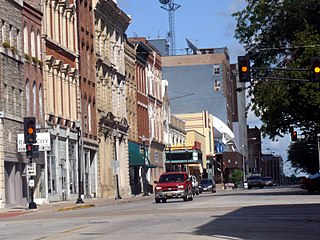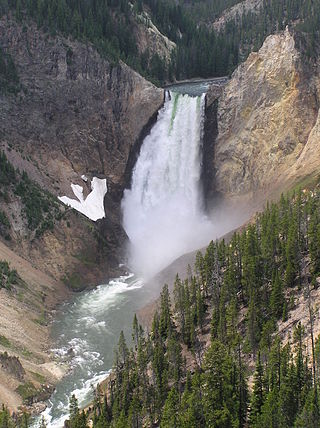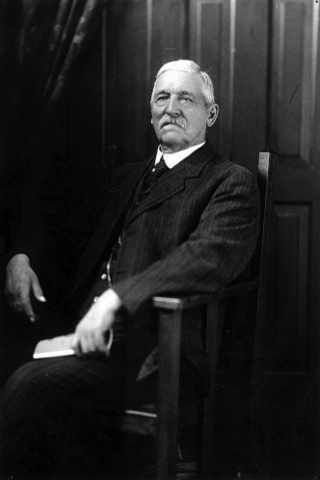Related Research Articles

Bismarck is the capital of the U.S. state of North Dakota and the county seat of Burleigh County. It is the state's second-most populous city, after Fargo. The population was 73,622 at the 2020 census, and was estimated to be 75,092 in 2023, while its metropolitan population was 133,626. In 2020, Forbes magazine ranked Bismarck as the seventh fastest-growing small city in the United States.

Council Bluffs is a city in and the county seat of Pottawattamie County, Iowa, United States. The population was 62,799 at the 2020 census, making it the state's tenth most populous city, and the most populous city in Southwest Iowa. The Omaha metropolitan region of which Council Bluffs is a part, is the 58th largest in the United States, with an estimated population of 983,969 (2023). It is located on the east bank of the Missouri River, across from Omaha, Nebraska. Until about 1853 Council Bluffs was known as Kanesville. Kanesville was the historic starting point of the Mormon Trail. Kanesville is also the northernmost anchor town of the other emigrant trails because there was a steam-powered boat which ferried the settlers' wagons and cattle across the Missouri River. In 1869, the first transcontinental railroad to California was connected to the existing U.S. rail network at Council Bluffs.

Scouting in Illinois has served youth since 1909. The state was the home of the Boy Scouts of America (BSA) founder, William D. Boyce.

Quincy is a city in and the county seat of Adams County, Illinois, United States, located on the Mississippi River. The population was 39,463 as of the 2020 census, down from 40,633 in 2010. The Quincy micropolitan area had 114,649 residents.

Mandan is a city on the eastern border of Morton County and the eighth-most populous city in North Dakota. Founded in 1879 on the west side of the upper Missouri River, it was designated in 1881 as the county seat of Morton County. The population was 24,206 at the 2020 census. Across the Missouri River from Bismarck, Mandan is a core city of the Bismarck–Mandan Metropolitan Statistical Area.

Yankton is a city in and the county seat of Yankton County, South Dakota, United States.

The Yellowstone River is a tributary of the Missouri River, approximately 692 miles (1,114 km) long, in the Western United States. Considered the principal tributary of upper Missouri, via its own tributaries it drains an area with headwaters across the mountains and high plains of southern Montana and northern Wyoming, and stretching east from the Rocky Mountains in the vicinity of Yellowstone National Park. It flows northeast to its confluence with the Missouri River on the North Dakota side of the border, about 25 miles (40 km) west of Williston.

Fort Mandan was the name of the encampment which the Lewis and Clark Expedition built for wintering over in 1804–1805. The encampment was located on the Missouri River approximately twelve miles (19 km) from the site of present-day Washburn, North Dakota, which developed later. The precise location is not known for certain. It is believed now to be under the water of the river. A replica of the fort has been constructed near the original site.

Fort Abraham Lincoln State Park is a North Dakota state park located 7 miles (11 km) south of Mandan, North Dakota,. The park is home to the replica Mandan On-A-Slant Indian Village and reconstructed military buildings including the Custer House.

The Loess Hills are a formation of wind-deposited loess soil in the westernmost parts of Iowa and Missouri, and the easternmost parts of Nebraska and Kansas, along the Missouri River.

There are 459 properties and historic districts listed on the National Register of Historic Places in North Dakota. There are listings in 52 of North Dakota's 53 counties.

America's 11 Most Endangered Places or America's 11 Most Endangered Historic Places is a list of places in the United States that the National Trust for Historic Preservation considers the most endangered. It aims to inspire Americans to preserve examples of architectural and cultural heritage that could be "relegated to the dustbins of history" without intervention.

Fort Buford was a United States Army Post at the confluence of the Missouri and Yellowstone rivers in Dakota Territory, present day North Dakota, and the site of Sitting Bull's surrender in 1881.
Fort Lincoln Internment Camp was a military post and internment camp located south of Bismarck, North Dakota, USA, on the east side of the Missouri River.

Transportation in Omaha, Nebraska, includes most major modes, such as pedestrian, bicycle, automobile, bus, train and airplane. While early transportation consisted of ferries, stagecoaches, steamboats, street railroads, and railroads, the city's transportation systems have evolved to include the Interstate Highway System, parklike boulevards and a variety of bicycle and pedestrian trails. The historic head of several important emigrant trails and the First transcontinental railroad, its center as a national transportation hub earned Omaha the nickname "Gate City of the West" as early as the 1860s.

Tracy Potter is an American historian, politician and former member of the North Dakota Democratic-NPL Party. He represented District 35 in the North Dakota Senate from 2006 to 2010 and in 2022. He was also the Democratic nominee for the U.S. Senate in 2010 and for Superintendent of Public Instruction in 2012. From 1993 to 2015, he served as executive director of The Fort Abraham Lincoln Foundation.
Gottlieb Charles Wachter (1865–1928), commonly known by his middle name, was a German-born businessman and city commissioner in Bismarck, North Dakota, USA. Wachter is best remembered as the patriarch of one of the earliest and most prominent families of North Dakota's capital city.
Northern Plains National Heritage Area is a federally designated National Heritage Area along an 80-mile (130 km) length of the Missouri River in central North Dakota. The heritage area promotes and interprets the scenic, cultural and historic heritage of the region. It extends from Knife River Indian Villages National Historic Site to Huff Indian Village State Historic Site The area interprets the history of the Three Affiliated Tribes, the passage of the Lewis and Clark Expedition, the fur trade, steamboats on the Missouri and Fort Abraham Lincoln. It also interprets the area's association with the Northern Pacific Railroad, as well as the area's heritage in agriculture and energy production.

Grant Prince Marsh was a riverboat pilot and captain who was noted for his many piloting exploits on the upper Missouri River and the Yellowstone River in the Western United States from 1862 until 1882. He began working as a cabin boy in 1856, eventually becoming a captain, pilot, and owner in a career lasting over sixty years. During that time, he achieved an outstanding record and reputation as a steamboat captain, serving on more than 22 vessels. His piloting exploits became legendary and modern historians have referred to him as "possibly the greatest steamboat man ever", "possibly the greatest [steamboat pilot] ever", "possibly the finest riverboat pilot who ever lived", and "the greatest steamboat master and pilot on both the Missouri and Yellowstone Rivers".

The Emilie was a sidewheel steamer, designed, built and owned by the famed riverboat captain Joseph LaBarge, and used for trade and transporting people and supplies to various points along the Missouri River in the mid nineteenth century. The Emilie was built in Saint Louis in 1859, was 225 feet in length with a 32 foot beam and had a draft of six feet. Larger than the average riverboat at the time, she could carry 500 tons of cargo. During her extended service on the Missouri River she also fell into the hands of both Union and Confederate soldiers during the Civil War. As a result of her numerous exploits, Emilie was among the most famous boats on the river and was widely considered a first rate and an exceptionally beautiful riverboat. After some nine years of service the Emilie was caught in and destroyed by a tornado on June 4, 1868.
References
- 1 2 3 4 5 "With LCD Group's help, 'The Landing' set to open and transform Bismarck's riverfront". LCD Group. 2022-04-11. Retrieved 2023-06-23.
- ↑ "Fort Abraham Lincoln Foundation". Missouri Valley Heritage Alliance. Retrieved 2023-06-24.
- 1 2 3 "Our History". Missouri Valley Heritage Alliance. Retrieved 2023-06-24.
- ↑ "ND's Fort Lincoln State Park to open May 1". Inforum. 2013-04-28. Retrieved 2023-06-23.
- 1 2 Holdman, Jessica (2018-06-08). "Riverboat event center breaks ground". Bismarck Tribune. Retrieved 2023-06-23.
- 1 2 Weiand, Zachary (2022-09-06). "$3.5 million Heritage River Landing operating in Bismarck; center linked to riverboat". Bismarck Tribune. Retrieved 2023-06-23.
- ↑ "Northern Plains National Heritage Area". National Park Service. Retrieved 2023-06-23.